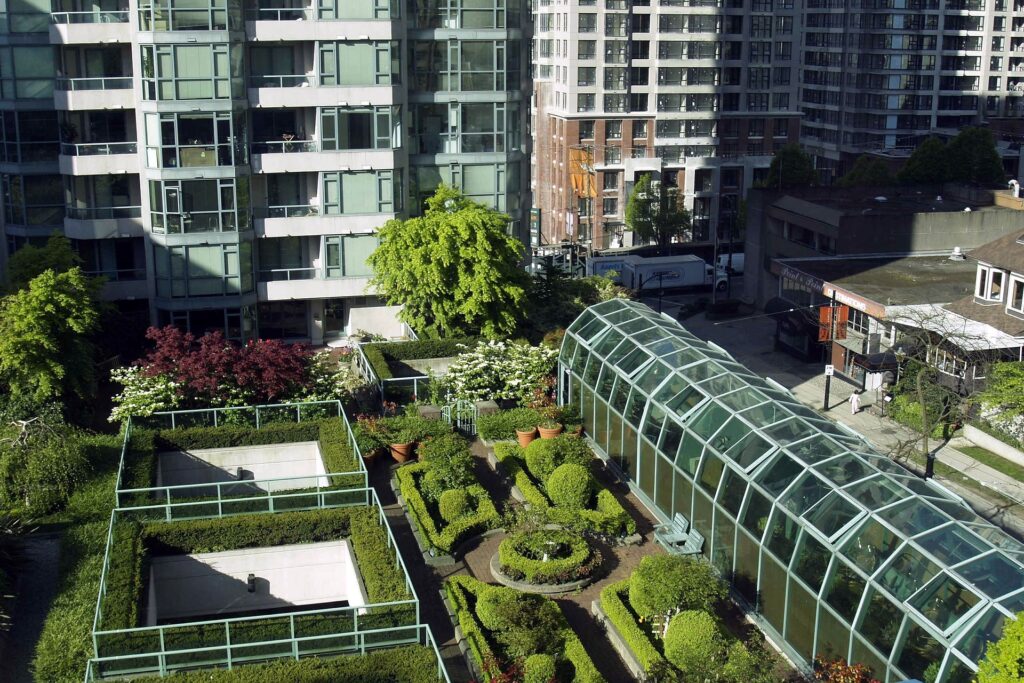Green roofs, also known as vegetated roofs or living roofs, are a unique and innovative solution for a variety of environmental, social, economic, and aesthetic benefits. They consist of a waterproofing membrane, growing medium, and vegetation overlying a traditional roof. If well-designed, engineered and maintained, green roofs can provide many benefits to building owners and the community as a whole.
Environmental Benefits of Green Roofs
Environmental Benefits Green roofs can play a significant role in reducing the negative impact of urbanization on the environment. They can help with stormwater management, reducing the flow of stormwater from a roof by up to 65% and delaying the flow rate by up to three hours.
They can also help to cool buildings, reducing energy consumption and creating a more comfortable living and working environment. Furthermore, green roofs can create new urban habitats for plants and animals, increasing biodiversity and reducing the urban heat island effect.
Economic Benefits of Green Roofs
Green roofs can provide several economic benefits for building owners. One benefit is a positive return on investment (ROI) for building owners. The General Services Administration (GSA) green roof report estimated that green roofs on commercial and public buildings provide a payback, based on 50-year average annual savings, of about 6.2 years nationally, internal rate of return of 5.2%, and an ROI of 224%, based on a net present value of $2.7/square foot. This means that building owners can expect to see a return on their investment within 6.2 years, with an annual return of 5.2%, and a total return of 224% over the life of the roof.
Another benefit of green roofs is a longer lifespan, which reduces the need for frequent roof replacements. This can save building owners money on maintenance and repair costs over time.
Best Practices for Green Roof Construction and Maintenance
Some best practices for green roof construction and maintenance include several key steps to ensure the optimal performance of a green roof.
Building Structural Support: A green roof can be heavy, so it is important to ensure the building can structurally support a green roof. This includes assessing the load-bearing capacity of the roof deck and reinforcing it if necessary, as well as ensuring that the drainage and irrigation systems are adequate.
Quality Installation and Leak Prevention:
Green roofs require a waterproof membrane to prevent leaks. It is important to ensure that the membrane is of good quality and properly installed to prevent leaks. Additionally, proper flashing and sealing should be used to prevent water infiltration around penetrations and at the perimeter of the roof.
Proper Maintenance:
Proper maintenance is crucial to the longevity and performance of a green roof. This includes regular inspections, irrigation and fertilization, weed control, and pest management. It is also important to remove debris and leaves from the roof to prevent clogging of the drainage system.
Unique Challenges:
Green roofs on historic buildings may have unique challenges. These may include concerns about the roof’s appearance, compatibility with the building’s architecture, and ensuring that the green roof does not damage the building’s historic features.
Climate and Weather Adaptation:
Green roofs require different maintenance and care depending on the climate and weather conditions. It is important to select plants that are appropriate for the region and to ensure that the irrigation and drainage systems are adequate to handle the local weather conditions. Following best practices for green roof construction and maintenance is essential to ensure the optimal performance of a green roof. This includes ensuring the building can structurally support a green roof, quality installation and leak prevention, and proper maintenance to avoid plant loss and other problems.
Climate and weather adaptation is also important. Working with a professional green roof contractor can help to ensure that these best practices are followed and the green roof is installed and maintained correctly. Future Research Needed for Green Roofs Green roofs are a relatively new technology, and as such, there is still much to be learned about their full potential.
Research in the following areas will help to further understand the benefits of green roofs:
Storm Dynamics:
Green roofs affect stormwater runoff during storms. Optimizing their design will help to manage stormwater. This can also help to identify any potential issues or challenges that need to be addressed in future planning.
Long-term Energy Performance:
Long-term studies can provide valuable information on how green roofs perform over time. This can help to identify any issues that may arise and provide insights into how to optimize the design and maintenance of green roofs.
Native Plants and Endangered Fauna:
Researchers need to identify the best plants and methods for creating habitats for native plants and endangered fauna by studying the topic.
Comparison of Green and White (Reflective) roofs:
Researchers need to com. pare the performance of green roofs with white (reflective) roofs in terms of energy efficiency, stormwater management, and overall environmental benefits by studying the topic. Researchers need to investigate how green roofs interact with solar panels and develop strategies to design them to work together as the use of solar panels on rooftops increases.
Rooftop Agriculture:
Rooftop agriculture is an emerging trend that involves using green roofs to grow food in urban areas. Research is needed to understand the economic benefits and potential for rooftop agriculture, as well as the best practices for designing and maintaining these systems.
Air Quality Improvements:
Green roofs can improve air numbers by reducing the amount of pollutants and particulate matter in the air. Researchers need to investigate how green roofs can improve air quality and the potential health benefits they can provide by studying the topic.
Rooftop Parks and Play area:
Rooftop parks and play areas can provide safe outdoor spaces for children and families in urban areas. Researchers need to understand how to design and use green roofs to create rooftop parks and play areas, and the potential benefits they can provide by researching the topic. Green roofs are a relatively new technology with a lot of potential.
Researchers need to understand the full potential of green roofs by:
- Studying stormwater and storm dynamics.
- Evaluating long-term stormwater and energy performance.
- Creating habitats for endangered fauna.
- Comparing green and white (reflective) roofs.
- Investigating the interaction between green roofs and solar panels.
- Assessing the economic benefits of rooftop agriculture.
- Examining the air quality improvements associated with green roofs.
- The potential of green roofs as rooftop parks and play areas for urban areas is also an area worth exploring.
Green roofs are an innovative solution that can provide many benefits to building owners and the community as a whole. They can help with stormwater management by reducing energy consumption. Green roofs create new urban habitats that could aid in crime reduction, and improving the overall appeal of a building. By installing a green roof a building owner can ensure their properties with a green roofs are a worthwhile investment.

